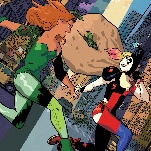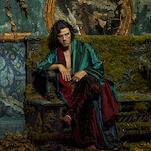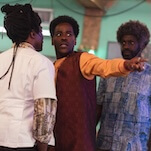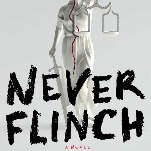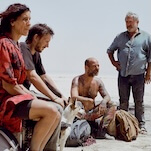Every two weeks, Big Issues focuses on a newly released comic-book issue of significance. This week, it’s My Favorite Thing Is Monsters: Book One. Written and illustrated by Emil Ferris, this graphic novel is a stunning debut that introduces a major new talent to the comics scene. (This review reveals major plot points.)
Let’s get right to the point: Emil Ferris’ My Favorite Thing Is Monsters is a masterpiece. It’s hard to think of a debut graphic novel in recent memory that has the visual splendor, narrative ingenuity, and emotional impact of this 413-page tome, and with this book, Ferris immediately establishes herself as one of the most exciting, provocative talents in the comics industry. Heavily inspired by Ferris’ own experience growing up as a monster-obsessed, alienated child in Chicago’s Uptown neighborhood, MFTIM follows a 10-year-old girl, Karen Reyes, as she tries to uncover the mystery of her upstairs neighbor’s death, which is declared a suicide by the police despite signs that suggest murder. That’s the general thrust of the graphic novel, but it’s just the starting point for a story that is massive in scope, moving from Uptown to Weimar-era Germany to explore the coming-of-age of two girls living in separate times of intense social and political turmoil.
In the original submission package for MFTIM, Ferris breaks down the individual elements that make up the book: mystery, memoir, historical fiction, humor, urban grit, romance, biting social commentary, and supernatural thriller. There’s a lot going on here, but Ferris gracefully blends everything together into one cohesive, riveting read. The mystery of Anka Silverberg’s death provides a starting point that branches out in all sorts of directions, and the book becomes more and more substantial as it delves into Karen’s relationship with the deceased. That relationship gains considerable depth when Karen learns about Anka’s past in Germany, a tragic tale of an abused Jewish girl who eventually finds her way to happiness and stability, which is taken away from her when the Nazis come into power. Karen and Anka’s stories weave together to form a rich narrative tapestry, one that is given greater impact thanks to Ferris’ mesmerizing visuals.
MFTIM is presented as Karen’s sketchbook, which tells the story with intricately crosshatched ballpoint pen illustrations on lined spiral-bound notebook paper. Ferris does astonishingly innovative work with this format, and while it’s highly unlikely that a 10-year-old would have Ferris’ skill with a pen, the sketchbook conceit gives the book a youthful spontaneity and emotional rawness. Ferris isn’t working within a traditional comic structure, often eschewing panels in favor of more fluid, expressive layouts that draw the reader deeper into the individual experiences of the characters. Environments are rendered with meticulous detail that makes each setting distinct, and the characters are overflowing with personality thanks to Ferris’ slightly exaggerated, highly specific facial expressions and body language. There are also moments when the exaggeration disappears to ground these characters in reality, and there’s an especially powerful transition late in the book where Karen reveals herself as she actually appears rather than the cartoonish version she puts on the page.
The technical prowess on display in MFTIM is incredible, and the materials Ferris uses send a message that says its possible to create fine art with everyday resources like ballpoint pens and notebook paper. Some of the images in this book could easily compete with pieces hanging in museums and galleries, and throughout the story, Ferris replicates major works of art to bring a completely different texture and dimension to the source material. Karen and her brother Deeze’s early trip to the Art Institute of Chicago is an opportunity for Ferris to show off this talent for duplication. Her versions of classic pieces like Georges Seurat’s “A Sunday Afternoon On The Island Of La Grande Jatte” and Bernat Martorell’s “St. George Killing The Dragon” reflect Karen’s distinct interpretation of the artwork, and Karen occasionally finds herself fully immersed in these works, exploring them from new angles that are dictated by her individual perception.
Originally set for release on Halloween of last year, the initial 10,000-book print run of MFTIM was seized at the Panama Canal on the way from South Korea after the shipping company filed for bankruptcy. It forced Fantagraphics to delay the book’s release, but it proved to be a serendipitous turn of events. MFTIM is even more relevant after the election of President Donald Trump, and it speaks to the current political climate in chilling ways. In the wake of increasing anti-Semitism in the United States, the flashbacks to Anka’s life during the rise of the Nazi party play like a terrifying vision of what could happen in the U.S. if a hate-mongering government goes unchecked. The bigotry experienced by Karen, her family, and her friends hasn’t disappeared, and the vernacular and policies of the current administration are fueling prejudice and fear rather than diminishing it.
The big thesis statement of MFTIM comes toward the end of the book as Karen considers the different kinds of monsters that exist in the world. Karen has idolized monsters for her entire life, specifically the strange, mutated outsiders that appeared in the late-night horror movies she catches on TV and the horror comics she reads voraciously, and she draws herself with werewolf-like features in her sketchbook. Karen considers herself and other misfits to be good monsters, people who don’t fit socially constructed views of what is normal and simply want to live their lives without hurting others. The bad monsters are the people who want to oppress, control, and/or destroy people that challenge their ideas, and this dichotomy is especially clear to Karen after the assassination of Dr. Martin Luther King Jr.:
The bad monsters want the world to look the way they want it to. They need people to be afraid…They don’t live in their lair and mostly mind their own biz… I guess that’s the difference… A good monster sometimes gives somebody a fright because they’re weird looking and fangy… A fact that is beyond their control… But bad monsters are all about control… They want the whole world to be scared so that bad monsters can call the shots…
This sentiment was true in Nazi Germany, it was true in 1968 America, and it’s true right now. The bad monsters have a fundamental lack of empathy for people outside of their own experience, which motivates behavior that causes significant damage to individuals and communities that are deemed “other.” MFTIM is a book steeped in empathy and the need to understand the complexities of people and their specific experiences. A big part of Karen’s growth involves the realization that the world is made up of shades of gray. Few people (if any) are wholly good or bad, and each person has their own personal baggage that they carry through life. Understanding this makes Karen both extremely compassionate and curious, and she wants to know about personal struggles because it helps her make stronger connections with the people around her.
MFTIM has gotten lots of attention from major news outlets like The New York Times, The New Yorker, The Guardian, and NPR over the last few weeks, and some of the biggest names in the industry have voiced their support of Ferris and her work. The front and back covers of MFTIM have pull quotes from Chris Ware and Allison Bechdel, and Art Spiegelman told The New York Times, “Emil Ferris is one of the most important comics artists of our time.” She’s not only important; she’s an inspiration.
Fourteen years ago, Ferris suffered a mosquito bite that gave her the West Nile Virus, paralyzing her from the waist down and causing major nerve damage in her right hand, which now shook and was too weak to hold a pen. Despite being told by doctors that she would not walk again, Ferris held on to hope thanks to the encouragement of her friends and family, and enrolled in the Art Institute Of Chicago’s M.F.A. program. She began classes in a wheelchair but graduated walking with two canes, and she attributes her recovery to the healing power of art. It’s a powerful story (which she turned into a comic for Chicago Magazine), and MFTIM is all the more impressive considering what Ferris had to overcome in its creation. She’s an amazing talent, and readers won’t have to wait long for another huge helping of Ferris’ work because the second book of MFTIM is slated to hit stands in October of this year, ideally hitting the release date that this first half was denied.










